Home
Introduction
Maps
Anatomy
schools
Mort
stones
Mort
safes
Watch
houses
Mort
houses
English
sites
Irish
sites
Images & data
Database
Slideshow
Links
A Body Snatcher's Tale
The Coffin Torpedo
Robin Laing sings Burke and Hare
|
- Resurrection
- The problem
- The solution?
The
need for an intact body
There
is a long religious tradition of resurrection from the dead leading
to eternal life. In many cultures it was thought that resurrection
was totally dependent upon the body being intact at burial.
In
ancient Egypt bodies were mummified in as lifelike a way as possible
as a way of providing a permanent home for the soul whilst effectively
denying and ultimately cheating death itself. Although the internal
organs were removed during mummification they were preserved in
canopic jars and carefully kept with the rest of the body.
In
the Christian tradition also it was taught that the body must be
kept intact for the day of resurrection. This explains the strong
opposition to cremation that continued into the 20th century.
It
is ironic therefore, that in Victorian times christians felt no
qualms in desecrating mummies by unwrapping them and even sent out
especially-printed invitation cards: 'Lord Londesborough at
Home: A Mummy from Thebes to be unrolled at half-past Two'.
Even less fortunate were those mummies exported to the US for use
in the papermaking industry or even, as Mark Twain reported, to
be burnt as railroad fuel.
However,
the slaughter of the first world war, in which millions of people
were literally blown to pieces, with no known grave, made it impossible
for the church to maintain its position on the need for an intact
body. One could hardly argue that those heroes who had died in such
horrible circumstances for their country were to be denied eternal
life.
For
several centuries this fear of the body being rent apart before
burial had brought medical anatomists and the general population
into direct conflict. A particular problem was the activities of
body snatchers, or resurrection men, who dug up newly buried bodies
and sold them to the anatomy schools to be dissected.
This
site deals with some of the ingenious ways by which the people of
Scotland tried to prevent their loved ones from falling into the
arms of the anatomists based in the University towns. |
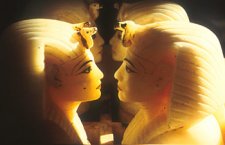
Tutankamun's canopic jars

Resurrection Scene
Reims Cathedral
North front

Death the reaper: Frank Hurley
|
Supply
and demand
Few
burial grounds in Scotland, it is believed, have escaped the ravaging
hands of resurrection men; and it is reported that with respect
to a church-yard not far from Edinburgh, that, till within three
years ago, when the inhabitants began to watch the graves, the persons
interred did not remain in their graves above a night, and that
these depredations were successfully carried on for nine successive
winters.
Rev.
W. Fleming, West Calder, Scotland. 1821
There has long been a demand for human corpses for dissection by anatomists and medical students. In Scotland, the involvement in anatomy and surgery goes back to 1505 when the charter granted to the ‘Incorporation of Surgeons and Barbers in Edinburgh’ stipulated that every candidate for admission should ‘know anatomea nature and complexioum of every member of manis body’.
Prior to the Anatomy Act of 1832 the main legal source of bodies was that of convicted and executed felons. The early Edinburgh surgeons, for example had to rely on one executed criminal’s body a year until, in 1694, Alexander Monteith opened his anatomy school and was promised ‘the bodies that dye in the correction house’. In 1636 when William Gordon, mediciner at King’s College in Aberdeen, petitioned thePrivy Council to be allowed to teach human anatomy, the Council instructed that Gordon should receive annually ‘Twa bodies of men, being notable malefactors, execute in thair bonds, especiallie being rebels and outlaws’.
This reliance on the bodies of executed criminals was to continue up to the early 1800s. Indeed penal dissection was very much part of the punishment to be inflicted. For example, when William Gordon was found guilty of murder in the High Court, Aberdeen on the 10th April 1822 his sentence was hanging by public executioner and his body to be delivered to Doctors Charles Skene and Alexander Ewing, lecturers in anatomy and physiology in Aberdeen medical school for public dissection.
Inevitably, as the competing University medical colleges and private schools of anatomy in Aberdeen, Edinburgh and Glasgow,grew in number and size the demand for bodies for dissection far outstripped the supply. The shortfall was increasingly met by the activities of a motley collection of unsavoury characters variously known as grave-robbers, body-snatchers, resurrection men, sack-‘em-up men, shusy-lifters, corp’-lifters, Burkers and noddies. They helped meet the demand for bodies by digging up fresh graves in the dark of the night and then selling the corpses to the local anatomists. The quotation at the top of this page taken from the writings the Rev. W. Fleming of West Calder well describes the horrendous scale of the problem.
Grave robbing was to remain a major problem until 1832 when a new Anatomy Bill was introduced and passed.
Under the Act those intending to practise anatomy had to obtain a licence from the Home Secretary. Regulating these licensed teachers, and receiving constant reports from them, were four inspectors of anatomy, one each for England, Scotland, Ireland and London, who reported to the Home Secretary.
The principal provision of the act was Section 7 which stipulated that a person having lawful possession of a body may permit it to undergo anatomical examination provided no relative objected. In Section 16, however, the old act of Henry VIII was repealed and the bodies of murderers were no longer to be given up for dissection after execution.
The Act, provided for the needs of physicians, surgeons and students by giving them legal access to corpses that were unclaimed after death, in particular those who died in prison or the workhouse. Further, a person could donate their next of kin's corpse in exchange for burial at the expense of the donee.
The act was effective and largely ended the scourge of the Resurrection Men.
|
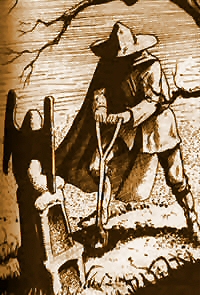
The Graverobber
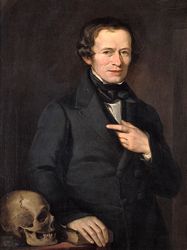
Dr Andrew Moir
Aberdeen Anatomist

From: Elementi di anatomia fisiologica
applicata alle belle arti figurative
Turin, 1837-39.
|
Populace versus bodysnatchers
This large scale desecration of graves led, as one can imagine, to a bitter battle of wits between on the one hand the outraged local populace endeavouring to protect the bodies of their loved ones and on the other the body-snatchers hell-bent on snatching them. The burial grounds of Scotland still bear stark witness to these ghoulish events of long ago. In many a kirkyard one can still see the physical evidence of the increasingly sophisticated methods that were employed to help protect the dead until they were too corrupt to be of interest to the anatomists.
An early and simple approach was to heavily compact the soil when filling in a grave and to put in several layers of branches to make digging more difficult. Sometimes prodigiously heavy slabs of stone known as mort-stones were placed on top of the grave to further deter the diggers. In 1816, Superintendent Gibb of the Aberdeen Harbour Works gifted such a mort-stone to St Fittick’s churchyard at Nigg. This stone seems to have disappeared but two other stones can still be seen lying in the cemetery at Inverurie. Mort-stones were not meant to be left in place permanently and once the body was putrefied the stone was removed until required for a new burial.
Time was to show that mort-stones were not really the answer to the problem, and the body-snatchers soon learned to dig down at the head end of the grave, then to break off the end of the coffin and to drag the out the corpse by the head. Clearly, a more effective means of defence was required. One solution was the 'coffin collar' a stout iron necklace bolted to the floor of the coffin and designed to prevent the body from being dragged from the coffin. Examples have been found at St Andrew's Cathedral graveyard and at Kingskettle
The next step in this arms race between populace and body-snatchers was the invention of the mortsafe, an iron cage that enclosed the coffin. A common model in the North-East consisted of a huge coffin shaped stone sitting on top of a stout skirt of riveted iron straps to prevent access from all sides. This device was placed over the coffin in the grave and then buried, but dug up again, after a suitable passage of time had elapsed, to be re-used over and over again. There is an excellent example of this kind of mortsafe lying upside down in the old Kirk yard at Towie.
An alternative design took the form of a heavy coffin-shaped box of cast-iron which was placed over the coffin in the grave and buried. Again, these iron coffin covers were eventually disinterred for re-use. One still lies against the in the kirkyard wall at Banchory-Devenick on the South Deeside road just a short distance from the 19th century Aberdeen anatomy schools.
The more wealthy members of society could make their lairs permanently impregnable by protecting them with stone walls and iron cages. Such devices are most commonly seen in the graveyards of the large University towns, for example in Edinburgh's New and Old Calton cemeteries.
Given their great weight and strength, mortsafes were probably highly effective in protecting graves. The downside was that their massive structure also meant that they were difficult to manoeuvre into and out of the grave and removing them, when the time came, could not have been a pleasant prospect. Thus it was that people began to adopt a quite different tactic, that of organising groups of men, often armed with muskets or blunderbusses, to stand guard in the graveyard during the hours of darkness. In order to make their task more tolerable, particularly during the long cold nights of winter, watch houses of various designs began to be erected in graveyards across Scotland.
At their simplest these watch-houses resemble small cottages, usually set within the kirkyard where they afford a good view of the graves. Like the one in the Nether Kirkyard at St Cyrus, they are usually consist of a single room furnished with a fireplace and chimney and with one or more windows from which to keep watch. Some, including the one at the Old Dyce graveyard near to Aberdeen Airport, have a gun-loop through the wall through which the guards could fire warning shots, or even take pot-shots at any intruders.
Other watch-houses were much more splendid and imposing structures. The one in Banchory Ternan graveyard, some 17 miles from Aberdeen, is a particularly splendid example. It is a circular, two-storied tower, the lower part probably being used as a sexton's store and the upper as a lookout. The upper floor is equipped with a fireplace and a window. In the woodwork below the window there is a loophole through which the guards could take a shot at anyone foolish enough to enter the graveyard. There is also a bell on the top of the tower which could be used to raise the alarm and to seek assistance. The date 1829 is incised in the stone above the bell.
Spending long winter nights in the graveyard could not have been a pleasant experience, however freely the whisky might have flowed, and this led to the development of the final and most sophisticated means of protecting the dead, the mort-house. Mort-houses were exceedingly solidly built windowless vaults, with massive walls and heavy wooden and metal doors. Bodies were stored in these impregnable buildings until decomposed and were then retrieved and buried in the usual way. They are to be found mainly in the North-East, stretching from Crail in the South to Marnock in the North.
The morthouse at Belhelvie, built in 1835 on the road North from Aberdeen, is typical. It stands at the south-west corner of the Kirk yard with its door opening onto the road outside and is a very substantial stone building indeed, 18 feet in length and 12 feet high. The roof is a solid granite arch protected from the weather by a pitched slate roof. The building is built of massive dressed granite blocks and has a single doorway reached down three stone steps and is protected by double doors. The inside of the mort-house contained two shelves on each side fitted with rollers to facilitate the movement of coffins into their correct position. The inner door of the mort-house is made of a sheet of iron and has a massive lock while the the outer door is made of strong oak planks, studded with iron bolts and equipped with 2 large mortice locks. The 2 keyholes are themselves covered and protected by two iron bars, one hinged at the top of the door and the other at the bottom. The bars meet at the centre of the door and pass over a stout metal loop where they are securely fastened with a padlock. To break into this building in the dead of night would have been a formidable task indeed.
What must be the ultimate in mort-house design is to be found in the graveyard at Udny Green in Aberdeenshire. This granite-built vault is unique by virtue of being circular in outline rather than rectangular. This, of course, affords great strength to the structure, making it almost impossible for anyone to start breaking through the walls. The vault is made of massive granite blocks and internally has a domed stone roof with external slating to keep out the weather. The outer door is made of a double thickness of oak studded with iron bolts and with the keyhole protected by a hinged iron bar, which is fastened into place by a padlock. The inner door is made from a sheet of iron and slides vertically in a pair of grooves, from a pit in the floor, rather than opening and shutting in the usual way. Once raised the iron door is kept in position by a stout chain padlocked to an iron eye set into the granite floor. Perhaps the most interesting feature is the circular platform on which the coffins were laid. It is made of stout oak planks and revolves on a central stone pillar. When a coffin was placed on the platform it was moved around a few feet to make space for the next coffin and so on. Eventually a coffin would come full circle and could be removed for burial, being by that time of no possible interest to the resurrection men. Ironically the Udny Green vault, the ultimate in impregnable mort-houses, become was to become obsolete as soon as it was built in 1832 thanks to the Anatomy Act that was published later the same year.
|
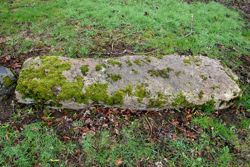
Inverurie mortstone

Kingskettle coffin collar
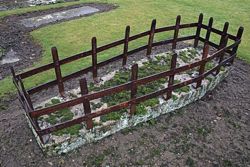
Towie mortsafe lying upside down
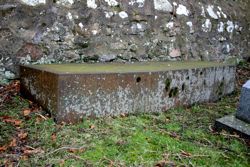
Banchory Devenick mortsafe

New Calton caged lair
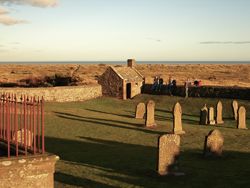
St Cyrus watch house
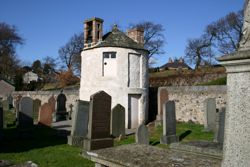
Banchory Ternan watch house
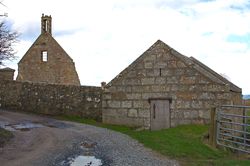
Belhelvie morthouse
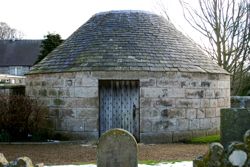
Udny Green morthouse
|
|